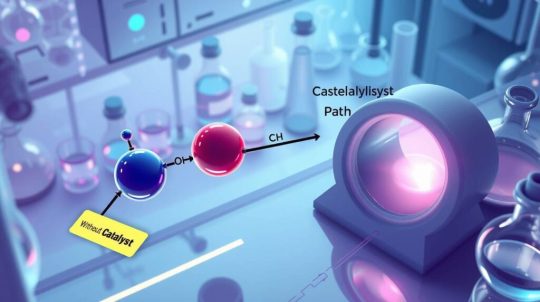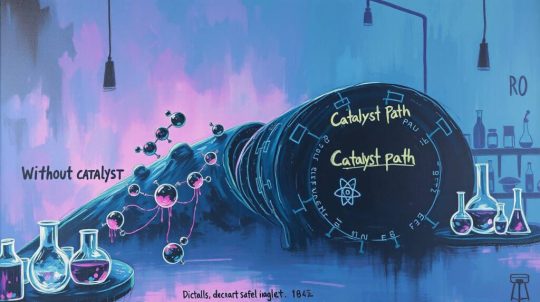#2025httpsedgythoughtscomhowdoesquantumentanglementwork2025
Explore tagged Tumblr posts
Text
Why Is Zero So Powerful in Math 2025

Why Is Zero So Powerful in Math 2025
📘 Book-Level Answer (University-Level – Mathematics & History) Zero, represented as “0,” is not just a placeholder or a symbol for "nothing"—it is a cornerstone of modern mathematics. The introduction and understanding of zero fundamentally reshaped arithmetic, algebra, calculus, computer science, and even philosophical reasoning in mathematics. 🔢 Mathematical Power of Zero 1. Zero as an Identity Element In arithmetic, zero is the additive identity, which means: a+0=afor any real number aa + 0 = a quad text{for any real number } a This property is foundational to number theory and linear algebra, especially when defining vector spaces and algebraic structures like groups and rings. 2. Zero in Algebra - Roots of equations: Solving for when an equation equals zero helps us find key points like intercepts and turning points. - Zero-product property: If ab=0ab = 0, then either a=0a = 0, b=0b = 0, or both — a crucial principle in factoring and solving equations. 3. Zero in Calculus - Limits and continuity: Zero plays a key role in limits. For example, limx→0sinxx=1lim_{x to 0} frac{sin x}{x} = 1 - Derivatives: The rate of change is often zero at maximum or minimum points. 4. Zero in Coordinate Systems Zero gives us the origin in a Cartesian coordinate system (0,0)(0, 0), a reference point from which we measure all other positions in geometry and physics. 5. Zero in Computer Science Binary code (the language of computers) is built using only two digits: 1 and 0. Zero represents the “off” state in logic gates and digital signals.




📜 Historical Significance of Zero - Ancient Origins: Zero was developed independently in ancient India (by Brahmagupta in the 7th century) and Mesoamerica (by the Mayans). - It revolutionized counting systems—especially the place-value system—making arithmetic operations like multiplication and division practical and scalable. 💡 Easy Explanation (Understanding Zero for Everyone) Imagine you're playing a game where you score points. If you have “0 points,” you haven't scored yet—but that still means something. Zero tells you where you are, even if it's at the starting point. Why is zero powerful? - It’s not just nothing—it’s a marker. A starting line. - Without zero, we couldn’t write big numbers like 1,000. You’d be stuck figuring out whether 1 is ten or a hundred! - It balances equations. If you want to keep things fair on both sides, you often use zero. In everyday life: - Bank account: If you have ₹0, you know exactly how much you have—not unknown or empty, but zero. - Temperature: Zero degrees is the point between freezing and not freezing—it's important! 🧠 Summary: - Zero is the additive identity. - It makes equations solvable and systems like calculus work. - It marks origin points in math and space. - It powers computer logic. - It revolutionized number systems and mathematical thinking. ⚠️ Disclaimer: The easy explanation is just to help you understand the concept in simple terms. For academic or exam purposes, always rely on the detailed explanation. If you score less for using this simplified version, we're not responsible—we're just here to make things clearer for learning purposes. 🔗 Related Reading from Our Blog: - How Does Quantum Entanglement Work 2025 https://edgythoughts.com/how-does-quantum-entanglement-work-2025 - How Do Gravitational Waves Affect Space-Time 2025 https://edgythoughts.com/how-do-gravitational-waves-affect-space-time-2025 🔗 External Source: - https://en.wikipedia.org/wiki/0 Read the full article
#20250101t0000000000000#2025httpsedgythoughtscomhowdoesquantumentanglementwork2025#2025httpsedgythoughtscomhowdogravitationalwavesaffectspacetime2025#additiveidentity#algebra#algebraicstructure#arithmetic#binarycode#binarynumber#brahmagupta#calculus#cartesiancoordinatesystem#computer#computerscience#concept#continuousfunction#coordinatesystem#cornerstone#derivative#digitalsignal#equation#explanation#factorization#freezing#geometry#gravitationalwave#groupmathematics#httpsenwikipediaorgwiki0#identityelement#identitymathematics
0 notes
Text
How Do Catalysts Speed Up Reactions 2025

How Do Catalysts Speed Up Reactions 2025
📘 Book-Level Answer (University-Level – Chemistry A catalyst is a substance that increases the rate of a chemical reaction without itself undergoing permanent chemical change. It functions by providing an alternative reaction pathway with a lower activation energy, thereby allowing more reactant molecules to possess the necessary energy to react at a given temperature. 🔬 How Catalysts Work: - Activation Energy is the minimum energy needed for a chemical reaction to occur. - A catalyst lowers this energy barrier, making it easier for molecules to collide and form products. ⚙️ Types of Catalysts: - Homogeneous Catalysts: These are in the same phase as the reactants (e.g., a dissolved acid catalyst in a liquid reaction). - Example: H⁺ ions catalyzing esterification. - Homogeneous Catalysts: These exist in a different phase than the reactants. - Example: Solid platinum catalyzing hydrogenation of ethene in the gas phase. - Enzymes (Biocatalysts): Special biological catalysts that speed up reactions in living organisms with extreme specificity. 🔁 Reusability: Catalysts are not consumed in the reaction. They participate in the reaction mechanism but are regenerated in the final step. 🧪 Reaction Mechanism (Example: Decomposition of H₂O₂): In the presence of manganese dioxide (MnO₂), the reaction proceeds as: 2H2O2→MnO22H2O+O22H_2O_2 xrightarrow{MnO_2} 2H_2O + O_2 - MnO₂ provides a surface and mechanism that reduces the activation energy, speeding up the release of oxygen gas.




💡 Easy Explanation (For Simpler Understanding) Imagine you're trying to climb a steep hill (the chemical reaction). It's hard and takes a lot of energy. A catalyst is like building a tunnel through that hill—it gives you a shortcut that’s easier and quicker to travel. In chemistry: - A catalyst helps the reacting substances (reactants) take an easier route to turn into the end products. - It doesn't get used up or disappear. You can use it again and again. - It's like having a helpful guide in a race who shows the fastest way without running themselves. Example in Real Life: Think about how your stomach digests food—that’s thanks to enzymes, a type of catalyst that breaks down food super fast compared to if your body tried to do it alone. 🧠 Summary Points: - Catalysts speed up reactions by lowering the activation energy. - They are not used up during the reaction. - They can be physical substances or biological (like enzymes). - They make processes faster, cheaper, and more efficient in industries and in your body. ⚠️ Disclaimer: The easy explanation provided is just to help you understand the concept clearly. If you're answering in exams or writing scientific reports, please use the textbook-style or university-level explanation. If you score less due to using the simplified version, we're not responsible—we're here to help you learn, not to replace academic sources. 🔗 Related Reading from Our Blog: - What If Human Consciousness Could Be Uploaded Into Light 2025 https://edgythoughts.com/what-if-human-consciousness-could-be-uploaded-into-light-2025 - How Does Quantum Entanglement Work 2025 https://edgythoughts.com/how-does-quantum-entanglement-work-2025 🔗 External Resource: - https://en.wikipedia.org/wiki/Catalysis Read the full article
#20250101t0000000000000#2025httpsedgythoughtscomhowdoesquantumentanglementwork2025#2025httpsedgythoughtscomwhatifhumanconsciousnesscouldbeuploadedintolight2025#acidcatalysis#activationenergy#catalysis#chemicalreaction#chemicalsubstance#chemistry#concept#consciousness#decomposition#energy#enzyme#ethylene#explanation#fromourblog#homogeneityandheterogeneity#homogeneouscatalysis#httpsenwikipediaorgwikicatalysis#hydrogenperoxide#hydrogenation#liquid#manganese#manganesedioxide#metabolicpathway#molecule#organism#oxygen#phasematter
0 notes
Text
What Causes Quantum Tunneling 2025

What Causes Quantum Tunneling 2025
Quantum tunneling is one of the most bizarre and fascinating phenomena in modern physics. Imagine a tiny particle breaking the rules of classical physics—passing through a barrier it seemingly shouldn't be able to cross. That’s quantum tunneling. In 2025, advancements in quantum field theory and nanoscale technologies have deepened our understanding of this phenomenon and its implications for both fundamental science and practical technologies. Let’s break down what causes quantum tunneling, how it works, and why it matters. Book-Level Explanation In classical physics, if a particle does not have enough energy to overcome a barrier, it simply cannot cross it. For example, a ball thrown at a hill that’s too high will bounce back. But in quantum mechanics, particles behave not just like solid objects but also like waves. This duality is at the heart of quantum tunneling. Wavefunction and Probability In quantum mechanics, the behavior of particles is described by a wavefunction (Ψ), which contains information about the probabilities of a particle’s position and momentum. This wavefunction does not abruptly stop at a barrier—instead, it exponentially decays within the barrier. If the barrier is thin or low enough, the wavefunction may still exist on the other side, indicating a non-zero probability that the particle will appear beyond the barrier, even though it doesn’t have the classical energy to cross it. This is quantum tunneling. Key Factors Causing Quantum Tunneling: - Heisenberg’s Uncertainty Principle: This principle states that one cannot precisely know both the position and momentum of a particle simultaneously. This uncertainty allows for small probabilities where a particle may momentarily "borrow" energy to overcome a barrier. - Wavefunction Penetration: The wavefunction associated with a particle doesn’t just vanish at the edge of a barrier. It decreases but continues through the barrier, leading to a probability that the particle can appear on the other side. - Barrier Characteristics: The thickness and height of the potential barrier affect tunneling probability. A thinner or lower barrier increases the chance of tunneling. - Quantum Superposition: A particle doesn't take a single path; it explores all possible paths simultaneously. This includes paths that involve penetrating a barrier. Mathematical Expression In simple cases, the tunneling probability (T) can be approximated as: T ≈ e^(-2κa) Where: - κ = √(2m(V − E)) / ħ - m is the particle’s mass - V is the barrier height - E is the particle’s energy - a is the barrier width - ħ is the reduced Planck constant This formula shows that tunneling is more likely when the barrier is thin, or the energy difference (V − E) is small.




Easy Explanation Let’s say you’re in a room with walls, and you don’t have the energy to jump over or break through them. In the classical world, you’re stuck. But in the quantum world, you’re like a ghost with a small chance of magically showing up on the other side—even though you didn’t go over or through the wall the normal way. That’s quantum tunneling. Particles like electrons are not just little balls—they’re also waves of possibility. These waves can “leak” through barriers. If the barrier isn’t too thick or too strong, the wave goes through a bit, and sometimes the particle appears on the other side. This doesn’t mean it breaks the rules—it follows the strange rules of quantum mechanics where “impossible” things are just very, very unlikely… but not impossible. Real-World Applications in 2025 Quantum tunneling isn’t just a curious theory—it powers technologies we use today and is central to cutting-edge research in 2025: - Semiconductors and Transistors: In modern electronics, especially in nanoscale transistors, tunneling can cause current leakage. Engineers now design devices that either reduce unwanted tunneling or exploit it. - Tunnel Diodes: These components intentionally use tunneling to allow current to pass through them in unique ways, enabling fast switching electronics. - Scanning Tunneling Microscope (STM): This device uses tunneling to create atomic-scale images of surfaces. It works by bringing a sharp tip close to a surface and measuring the tunneling current between them. - Nuclear Fusion and Radioactive Decay: In stars, particles tunnel through barriers to fuse and release energy. Alpha decay in unstable atoms is also caused by quantum tunneling. - Quantum Computing: Tunneling is a key aspect of quantum bits (qubits) and how they behave inside superconducting quantum circuits. Why This Matters Understanding quantum tunneling helps scientists and engineers unlock the potential of quantum mechanics for both theoretical advancements and practical technologies. In 2025, it plays a pivotal role in: - Quantum chip design for faster processors. - Quantum sensors with extreme precision. - Energy solutions, especially in fusion research and superconductivity. Tunneling shows us how reality works on the tiniest scale—and reminds us that the universe is far more flexible and strange than our everyday experiences suggest. External Link for Further Reading: For a deeper dive into the physics of tunneling: https://en.wikipedia.org/wiki/Quantum_tunnelling Our Blogs You Might Like - What If Time Travel Became Scientifically Possible 2025 https://edgythoughts.com/what-if-time-travel-became-scientifically-possible-2025 - How Does Quantum Entanglement Work 2025 https://edgythoughts.com/how-does-quantum-entanglement-work-2025 Disclaimer: The easy explanation is provided to make the concept accessible to everyone, including beginners. If you're a student preparing for exams, always refer to your official textbooks, class notes, and follow academic guidelines. Our goal is to help you understand—not replace formal learning. Read the full article
#20250101t0000000000000#2025httpsedgythoughtscomhowdoesquantumentanglementwork2025#2025httpsedgythoughtscomwhatiftimetravelbecamescientificallypossible2025#alphadecay#alphaparticle#basicresearch#behavior#centralprocessingunit#classicalantiquity#classicalphysics#computing#concept#education#electron#electronics#energy#explanation#expressionmathematics#fieldphysics#formula#fusionpower#height#information#integratedcircuit#leakageelectronics#learning#mathematics#matter#mechanics#microscope
0 notes